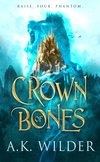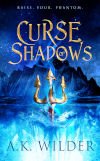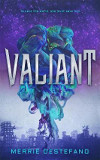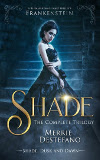.
This year, I’m focusing on magic systems in Fantasy – and wherever possible, I hope to do so by talking with a fellow author about the magic systems in their work.Today
I'm really pleased to welcome TeresaFrohock to discuss the magic systems in the world of her LOS NEFILIM series. In particular, we'll be talking A
Song With Teeth, the final book in her current series, which is due out
on February 9.
At which point I really must pause to vigorously deploy my fan,
breathless with excitement. J By which you
may deduce that I am a keen LOS
NEFILIM reader, aka a fan!
Background
By way of background for those who
may not be as familiar with the storyline as I am, it is set in 1930s Spain,
and Europe, during and after the Spanish Civil War. The preceding novel, Carved From Stone and Dream, is set on
the cusp of World War 2 (WW2),
and A Song With Teeth, the third and final novel takes place
during the latter war.
.
Overlapping
the human story of these tumultuous times is a paranormal conflict in which
angels and demons war on the human plane. The nephilim (in Spanish, Los
Nefilim) are the foot soldiers and frontline troops in their war. Inevitably,
the conflict spills over into human politics and concerns, and also reflects
them, with nefilim (I shall use the story’s Spanish spelling from this point) on
opposing sides in Spain’s civil war and WW2.
Welcoming T Frohock: In Conversation On Magic Systems In A Song With Teeth (LOS NEFILIM #3)
.
HL: Congratulations, Teresa, on the
imminent release of A Song With Teeth.
I imagine it feels like a considerable achievement to see the culmination of a
storyline encompassing both this LOS NEFILIM series and the earlier novella
trilogy?
.
TF: Thank you! It really did. This is actually the
first trilogy [tetralogy, if you count the Los Nefilim omnibus] that I’ve had
the opportunity to complete for a publisher, so it’s a milestone for me. I
enjoyed the ability to follow Diago’s character arc to completion,
and I was very satisfied with where the story ended in both terms of plot and
characterization.
.
HL: How do you feel the magic within LOS NEFILIM
influences and shapes the world and the story?
.
TF: For those
who haven’t read the series, the nefilim work their magic through music, light,
and movement by creating sigils. They experience sound accompanied by color—a
form of chromesthesia—that enables them to use the vibrations of color to shape
their sigils, which manifest their willpower into reality.
For example: if a nefil wants to
influence the weather, they design a sigil—a magical symbol—that will cause
rain. Then they compose the necessary tonal sounds that reflect the strength of
the storm they want, and then, as the song unfolds, they use their hands to
shape the colors of those sounds into the sigil. The final step is to push the
sigil into the clouds.
Since
the nefilim spend a lot of time together, they also perform together with informal
arrangements that deepen their camaraderie. Music isn’t just their way of working
magic; it’s also how they relax and form bonds with one another.
When
they first meet, often they play for one another. This is a way in which they
can see the other nefil’s song, or their soul. They judge one another by the
tonal quality of their voices and the complexity of their compositions, including
their ability to play instruments.
Although
their music plays an important part within their magic, they rely more on their
cunning and their ability to manipulate mortals than they do magic. They
navigate a treacherous world that can turn on them in a heartbeat, and they
know that as the twentieth century moves forward, scientists would love to
study the nefilim’s near immortality in addition to their ability to influence
events.
Because
they distrust mortals, the nefilim spend more time trying to stay hidden from a
sense of self-preservation. They move in plain sight, but they keep their magic
quiet unless threatened.
HL: “Music” is the key word I
associate with the LOS NEFILIM magic system, but given the intricacy of the magic
system you’ve just described, are there deeper layers that go beyond music
alone?
.
TF: It’s a
complex process that relies on physical gestures, as well. Music enables the
nefilim to transpose sound into emotion, which is a big component of
their magic, but they also have to form the sigils that manifest their will, so
it’s as much akin to dance as it is to music.
In A Song with Teeth, Diago
notes a young nefil’s magic, which is inadequate because even through the nefil
“understood
both technique and style—the accents landed in all the right places, the chords
were precise—but the cellist’s execution seemed to lack spirit and emotion,
which left the interpretation flat.” In spite
of his knowledge of structure and technique, the young nefil can’t convey the
necessary emotive chords necessary to work his magic.
This is why older nefilim are much
more dangerous than younger ones. Older nefilim have had centuries to design a
full repertoire of sigils and sounds and have perfected their techniques. They
have a wealth of personal experiences to draw from, and their movements are
lightning fast, while younger nefilim, especially those in their firstborn
lives, are still having to think their way through their spells.
Magic is never easy. If it was,
anyone could do it.
.
HL: The main character, Diago,
and his magic, are unique among the nefilim. Why is that? Is it important to
the resolution in A SONG WITH TEETH?
.
TF: One aspect to the nefilim’s magic that I haven’t
discussed is their distinctive vocal ranges. The angels in the Los Nefilim
series have three sets of vocal cords, which allows them to manipulate sound in
unique ways. As the children of angels, the nefilim are also able to produce
exceptional range with their voices (think of someone like Freddie Mercury or
Annie Lennox).
The angel-born nefilim (those born
of an angelic parent and a nefil with angelic lineage) have exceptional range
in the tonal expressions. The daimon-born, on the other hand, are better
skilled at the interpretation of pieces.
Diago is unique in that his mother
was an angel and his father was a daimon-born nefil. It was a rare coupling
that had never been replicated until an angel manipulates Diago into the sexual
relationship that produces Rafael.
Whereas Rafael is one-quarter
daimon, Diago is half, which makes him the best of both worlds. His unique
tonal range, along with his ability to interpret a piece of music with deadly
precision, enable him to compose and work with music far beyond the range of
any nefil who is merely angelic or daimonic.
He is able to drift between two
distinct cultures and bring what is best to both in the nature of his personal
song. His son, Rafael, accidentally discovers the secret to his father’s magic
in A Song With Teeth, and that revelation gives him a deeper
understanding of both his own song and that of his father.
.
HL: Family, both born and found,
is central to the main characters and the LOS NEFILIM story. Does this shape
the magic system in any way?
.
TF:
In many ways, yes. The angels want to breed the perfect soldiers, and in
doing so, they create nefilim with unique songs. Likewise, so do the daimons. Whoever
wins their war wins control of the mortal realm.
The
thing to remember is that to be chosen to parent a nefil born of their
respective gods (be it angel or a daimon) is considered to be a great honor
among the nefilim. Diago’s case is different, because his son’s angelic mother
chose to deceive Diago and used her enchantments to rape him. She never
intended to give Rafael to either the daimons or to Diago. It was only when she
lost complete control of the situation that she was able to hide Rafael and get
word to Diago of their son’s whereabouts.
At
the same time, the small family of Guillermo, the leader of Los Nefilim, is tight. His daughter, Ysabel,
benefits greatly by the presence of her angelic mother, Juanita, who chose to
remain on the mortal plane with both Guillermo and Ysabel (not all angelic
parents remain in the mortal realm with their off-spring). Together, they
nurture Ysabel, enabling her to grow into a strong, confident young woman.
I
didn’t want the stories to indicate that either blood relations or found
families were superior. The important thing is the respect and encouragement
they give to one another. That is where they draw their strength.
.
HL: Are there any significant new developments readers should look for in the
magic of A Song With Teeth?.
.
TF: I believe A Song with Teeth probably
has more magic in it than all the other books combined. We get to see the
daimonic courts in action and experience some of their magic. More important,
we get a glimpse of Ysabel and Rafael as young adults, which is something I had
a great deal of fun writing.
The
best part, for me, was that I was able to resolve all the tiny little threads
that spun from the novellas through the novels. I left them all in a good
place, and that was important to me, too. You never know what will happen next.
I’ve got a few shorts planned for this upcoming year, and we may eventually see
them all again one day … until then, watch for them.
.
HL: Teresa, I definitely shall! By the way, may I say how much I love that
catchphrase “Watch for me”? It’s so evocative in itself, but also of the
ongoing story. Thank you so much, too, for doing the interview today. I thought
I knew the magic system of LOS NEFILIM pretty well but you’ve definitely added more
depth – and no question, I shall be eagerly watching for A Song With Teeth on
February 9.
.
To find out more about A
Song With Teeth and LOS NEFILIM, please visit Teresa's website or her publisher's site:
HarperVoyager – A
Song With Teeth
They'll point you to where the book is available!
~*~
About T Frohock
T.
Frohock has turned a love of history and dark fantasy into tales of deliciously
creepy fiction. A real-life cyborg, T. has a cochlear ear implant meaning she
can switch you on or off with the flick of a switch. Make of that what you
will. She currently lives in North Carolina where she has long been accused of
telling stories, a southern colloquialism for lying.
You
can find T. on her website, here
and on Twitter: @T_Frohock
.
Rocking 2021 with “Magic Systems in Fantasy”
on Supernatural Underground: Previous Posts
January
1: Happy
New Year – Ushering In A Year of Friends, Fellow Authors, & Magic Systems
January
2: An Interview with AK Wilder – Talking Magic In Her New-Out Crown Of Bones (AMASSIA#1)
~*~
About The Interviewer:
Helen Lowe's first novel, Thornspell (Knopf), was published to critical praise in 2008. The second,The Heir of Night (The Wall Of Night Series, Book One) won the Gemmell Morningstar Award 2012, and the sequel, The Gathering Of The Lost, was shortlisted for the Gemmell Legend Award in 2013. Daughter Of Blood (Book Three), was published in 2016 and Helen is currently completing the final novel in the series. She posts regularly on her “…on Anything, Really” blog, monthly on the Supernatural Underground, and tweets @helenl0we











































